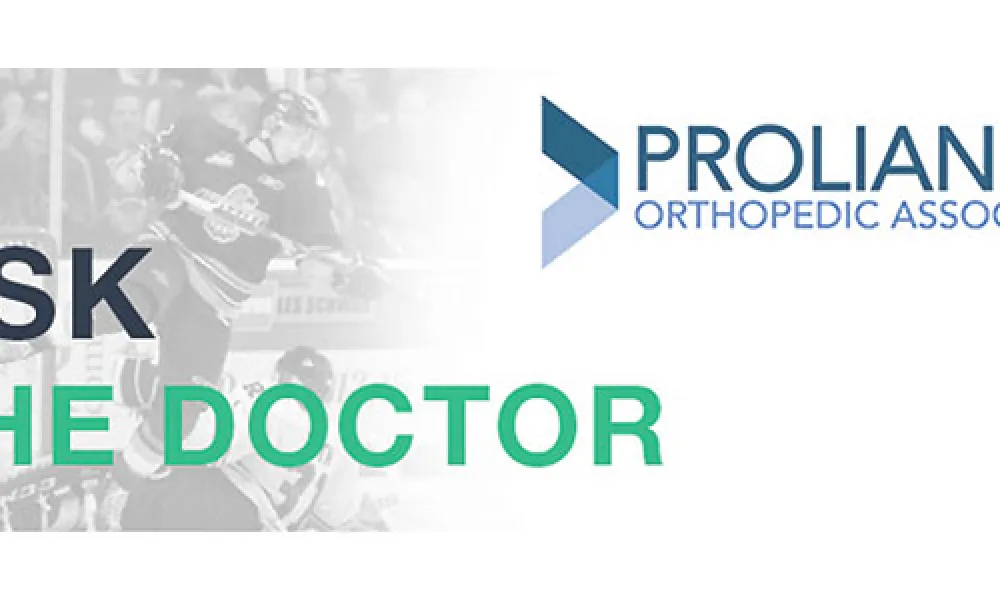Orthopedic physicians from Proliance Orthopedic Associates have been the team doctors for the Seattle Thunderbirds of the Western Hockey League since 2010. Sports medicine doctors, like Ty C. Jones, MD, provide in-game medical treatment, orthopedic surgery, and advice about physical therapy to T-bird players and staff. Dr. Jones also answers general medical questions in the Ask The Doctor section of the T-Birds official website.
The following is Dr. Jones’ response to T-Birds fan Julia, who asked, “Are there any other types of shoulder separations? Other than 2?”
Dear Julia,
Thank you for the interesting question! While there is a 1-3 grading scale for joint sprains, we often describe shoulder separations by “type”. They are better classified as Types I-VI. Also the term “separated shoulder” is a slang term for an “acromioclavicular joint sprain”. That’s a mouthful, so we usually abbreviate the joint to just the “AC joint”. This joint is above the part of the shoulder where your arm (humerus) connects with your shoulder blade (the scapula). It is where your collarbone (clavicle) meets with the outside tip (acromion) of the shoulder blade. This joint gives the shoulder extra stability, especially with reaching overhead. The term “separated shoulder” mostly has to do with the fact that these two bones separate when injured, and the end of the collarbone pops up and a bump shows up on the top of your shoulder. These injuries most often result from a fall or hit directly on the shoulder.
Let’s tackle that grading system. Think of a joint as two bones held together by ligaments (bands of connective tissue), and a sprain as an injury to one or more of those ligaments. With any sprain of a joint, a doctor, athletic trainer, or physical therapist can use a 1 to 3 scale to describe its severity, 1 being mild and 3 being severe. A grade 1 sprain means that the ligaments holding the joint together were stretched or very mildly torn, but the ligaments are not injured so badly that they are loose. On an x-ray, for instance, no bones have shifted out of place. A grade 2 sprain is a partial tear of a ligament or group of ligaments that allows some shifting of the bones that they hold together. A grade 3 sprain is a complete tear; the bones of the joint are no longer held together by that ligament.
When talking about AC joint sprains specifically, we use a more complicated type I-VI system instead of a grade 1-3 system, because there are TWO groups of ligaments that hold the collarbone in position. These injuries are a little more complex. Aside from the ligaments that hold the collarbone and the shoulder together at the outside tip of the collarbone (called the acromioclavicular or AC ligament), there is also a ligament a little more inward on the clavicle that tethers it from below. This is called the coracoclavicular or CC ligament. A Type I sprain is straightforward in that there is a stretch or small tear in the AC ligament itself. The shoulder is tender, but the collarbone has not been displaced at all. In a Type II sprain, the AC ligament is completely torn, and the CC ligament is partially damaged. Untethered at the far end and loosened from the bottom, the far end of the collarbone now shifts up; this is the traditional separation you see on the top of your shoulder during one of these injuries. A Type III sprain involves a complete tear of both of those ligaments causing a worse, clear and significant separation of the AC. A Type IV sprain is similar to a Type III in that both the AC and CC ligaments are torn, but the end of the clavicle gets pushed back and stuck in the trapezius muscle behind it. A Type V is similar to a Type III, but the end of the clavicle is significantly higher in a Type III. A Type VI occurs when the collarbone is forced down and gets stuck behind a bone called the coracoid. This is very rare and is more likely seen in high-speed injuries like car accidents, and not so much in a hockey.
What does that mean? Well, while that is for you and your doctor to work through, typically Type I-III sprains can be managed with a sling for a short while, rest and rehab. These can take anywhere from a couple of weeks to a couple of months to feel normal depending on the severity of the injury. Type V sprains are usually unstable and require surgery to bring the collarbone back down to the level of the shoulder. Types IV and VI typically require surgery to release and reset the trapped collarbone.
I hope, Julia, that you avoid this injury. In case it’s too late — that bump may never completely go away, so I hope there’s a good story that goes along with it!
If you need help with this or any other Sports Medicine need, please come see us at Proliance Orthopedic Associates in Renton, Covington, or Maple Valley.
Sincerely,
Dr. Ty Jones, M.D.
Proliance Orthopedic Associates
Read the article on the Thunderbirds’ site.

